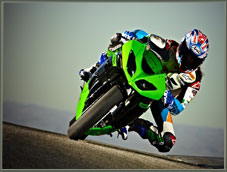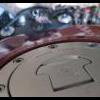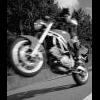BMW’s timing was just right. Due to the economic meltdown, the two-year cycle for sportbike updates finally came to an end. And as it were, BMW took aim to diversify and conquer the exclusive literbike wars.
The result was the S1000RR, and by now everyone knows how that quest turned out. If you don’t, you can read about Kevin’s first ride and our 2010 literbike shootout. BMW fans (and sportbike enthusiasts in general) came to expect big things from the German brand and the manufacturer knew it would have to bring not just any gun to the gun fight, but a cannon. Boy did it ever.
With almost 176 horsepower touching the tarmac at the flick of the wrist, the S1000RR easily trumped all of the other players in our 2010 literbike shootout. Add to that a chassis that performs on par or better than everything else out there, and an electronics package that’s second to none, and you can see why we named it our 2010 Motorcycle of the Year.

But the times, they are a-changin’. By 2010 Kawasaki’s flagship ZX-10R was getting a little long in the tooth and was in need of a revamp. On the global competition stage, the Zed wasn’t doing too well either, with poor finishes in World Superbike despite Team Green pulling out of MotoGP to focus on its production bikes.
All-new for 2011, Kawasaki’s ZX-10R, like Charlie Sheen, has one goal in mind: winning.
Which was true, except the focus wasn’t on the current model, but its successor: the 2011 ZX-10R. Editor Duke covered the changes in his tech piece, and Pete was lucky enough to flog Kawi’s latest literbike at Road Atlanta during the press intro for his first-ride story.
With its all-new design and standard traction control, Team Green’s latest weapon has created a lot of buzz, so we decided to cut the fluff and pit the latest contender against the reigning literbike champ, the S1000RR, in a mano-a-mano matchup for outright honors. Since the other machines in this class are virtually unchanged for 2011, we felt no need to include them. The KTM RC8R is a notable exception, as it has received some key revisions for the new year, but unfortunately one wasn’t available to us in time for this test.
This particular shootout centers around how this pair of literbikes function dynamically at a racing circuit. We’ll soon follow it up with a street-only comparison test.


Tale of the Tape
Unchanged for 2011 except for new colors like this Shine Yellow Metallic, the BMW S1000RR is still the bike to beat in the liter-class wars.
We’ve covered the key features of each motorcycle in detail in each of their respective stories above, but let’s rehash the important stuff: namely the powerplants and how to tame them. Obviously, each is powered by a 1000cc engine, though the BMW sports a highly oversquare bore and stroke of 80.0 x 49.7mm, compared to the Kawasaki’s 76.0 x 55.0mm, meaning the German machine is able to spin faster. This is important because, given the same displacement and number of cylinders, one of the ways to generate more horsepower is to increase engine speed.
Clearly BMW engineers are no stranger to this principle, as our S1K test bike rolled the DynoJet drum at Evan Steel Performance to the tune of 185.9 horsepower at 13,300 rpm and 79.3 ft-lb. of torque at 10,500 rpm. Remember, our test mule is bone stock and not some modified race machine. We knew all along that the BMW made astronomical power, but these numbers still make our eyeballs bulge... especially when sitting in the saddle!
The Kawasaki is no slouch either. Its 163 ponies at 11,500 rpm and 73.6 ft-lb. of torque are nothing to laugh at. Astute 10R fans may notice a horsepower deficit compared to its European counterparts. This is due to sound pollution requirements that put a damper on the fun in this country (as if 163 horsepower wasn’t fun already...). To meet these regulations, the ECU on the U.S. models partially closes the secondary butterflies after 12,000 rpm — 1500 rpm shy of redline — thus meeting the requirement, but also killing off the engine’s top-end surge.
The drop in power is clear on the dyno chart, too. Our friends across the pond report their bikes making around 13 more horses than we do. Thankfully, that power is attainable to us with a few strokes of a keyboard, as some clever aftermarket tuners are starting to discover.
An analog tachometer dominates the BMW’s gauge cluster, while digital displays relay everything else. The different power modes are adjustable via buttons on the switchgear.
With literbikes getting more powerful, the manufacturers have finally reached a point where traction control is practically a requirement to help keep average riders safe from themselves.. Ducati was the first in the class to introduce a true form of traction control in a production machine in the 1098R, but BMW raised the bar even higher with the S1000RR. Incorporating bank angle sensors and throttle position sensors in addition to wheel speed sensors, it was the most advanced system to date.
All the instrumentation is accessible via buttons on the switchgears, and the display on the gauge cluster tells you exactly what was going on. Not only that, but different power modes are at the rider’s disposal as well, to practically tailor the machine to a rider’s skill set.
Kawasaki took a different approach. Bank angle sensors and gyros were ditched in favor of sensors monitoring wheel speed, gear position, and throttle position. Simply put, when the rider twists the throttle, the computer calculates the rate of change among these different sensors — every five milliseconds — and plots a path that gives the optimum amount of power for the amount of traction the sensors are reading. Depending on the level of intervention, wheelspin is still possible for those who prefer steering the motorcycle with the rear tire.


Off Come The Gloves
Enough with the boring details, we came here to see how these two fare against one another. By ”here” we mean Buttonwillow Raceway Park, just outside of Bakersfield, California. Our friends at Lets Ride Trackdays were gracious enough to be our host for the day while we circulated the track in this battle royale of sorts.
First impressions? Both bikes feel awfully similar from the saddle. Our testers didn’t notice a discernible difference in ergonomics. Adjustable rearsets on the Zed, set to the high position for our day at the track, definitely help account for that feel (an option the BMW doesn’t have), but this similarity has us wondering if the OEMs have found an ideal setup or if this was just coincidence. Pete was really impressed by the new ergos of the Kawi compared to the previous version, saying it reminded him more ”of a supersport than a literbike.” He also noted that the flatter tank surface made it more comfortable for him in a full tuck.

It didn’t take long to know this was going to be one hard test to decide. ”Both of these bikes remind me of just how far along development of supersport bikes has come,” says Duke. ”It wasn’t long ago there were clear winners and losers in literbike shootouts. Today, the lowest-ranked literbike is still a highly desirable piece of kit.”
Indeed. By no means is the new ZX-10R slow, but it still gives up over 20 horses to the BMW. Fortunately, the green machine is now among the lightest in the category, tipping the scales at a claimed 437 pounds wet, a 16-pound advantage over the BMW that puts it right in line with the lightest bike in the class, Honda’s CBR1000RR. Truth be told, the tight and bumpy confines of Buttonwillow never really allowed us to experience brutal full-throttle acceleration for more than a second or two on either machine, but our subjective butt-dynos all agreed that the S1000RR’s potent engine is still the king of the class.
”With the amount of torque and horsepower the S1000RR makes, it doesn’t take but a heartbeat before you’re hauling the mail!” wrote Pete in his notes. The Beemer’s powerband is quite broad, rising to a blistering crescendo up top. Its only power-delivery issue is slightly abrupt throttle response in Slick mode (the least-intrusive TC setting) when engaging from off-throttle to on. Pete was able to rectify the issue with little side effect by switching to Race mode, which relies on the ECU to moderate the degree of throttle opening at a rate slightly slower than what the right wrist is indicating but still delivering maximum power.
A weight reduction and a new chassis endow the 2011 ZX-10R with its best-ever handling qualities.
”You can carve a good pace in the mid-level Sport mode,” Kevin observes, ”but it does interrupt power wheelies and restricts power while leaned over. Fast track riders will at least want to choose Race mode.”
For its part, the Kawasaki feels nearly as explosive in the midrange. Its lighter weight definitely plays a part there. Fueling is spot-on everywhere except in off/on transitions, just like the BMW in Slick mode. It initially caught us off guard, but we were able to adapt to it. Experimenting with the two lesser power modes also seemed like a band-aid fix.
Despite the fact that Buttonwillow’s layout doesn’t encourage full-throttle blasts, those few moments where that’s possible revealed the difference between each bike’s top end power. As you saw in the Kawasaki’s dyno chart, power ramps up in a linear fashion all the way to 12,000 rpm, where it disappointingly flattens out. We’ve got Big Brother to thank for that, and the resulting lull in top-end power is felt in the saddle. I described it to my cohorts as feeling like a racing greyhound attached to a really long leash that’s just short of the finish line.

Traction Control Comparison

With all this power on tap, getting the rear to break loose is a simple task. Kawasaki’s S-KTRC is touted by the company to be the latest advancement of traction control, one that can ”predict” your intended path. That said, the fact that none of us could definitively tell when the system was working in the first or second settings (least intrusive and medium intrusion) should serve as a testament to its seamlessness, especially considering the standard Bridgestone BT-016 rear tire fitted on our test bike was only losing grip as the day went on.
In contrast to the BMW, the Kawasaki’s power modes and traction control settings are manipulated via this single switch.
Our Metzeler Racetec K3-shod S1000RR had a tougher time spinning the rear due to the near race-spec level of rubber, but nonetheless the DTC system did make itself more noticeable, especially in the more intrusive modes (Race, Sport) as you’d expect. Part of the reason for this comes down to the bank angle sensors that limit power past a certain degree of lean. That said, for the average trackday rider, we feel that BMW’s DTC will still help you achieve quicker lap times. In Slick mode, the intrusion was difficult to notice — if it even kicked in at all — leading Kevin to comment, ”you would have to be an exceptional racer to feel hindered by the DTC’s parameters in Slick mode.”
We did like the single switch on the left switchgear of the Kawi that allowed us to adjust the different settings and power modes. It’s simple, convenient, and easy to operate with a gloved hand. Additionally, the 10R’s dash display was easier to distinguish and read, thanks to bigger letters and more pronounced contrast. Its new LED bar-graph tachometer (adjustable for brightness) is easy to see. The BMW’s buttons aren’t difficult to figure out, but the smaller ”Mode” button is less intuitive. Likewise, the smaller font on the gauge cluster is now a minor setback in our opinion.
The Details
Being a track test, riding both bikes back-to-back shed a lot of light on their handling characteristics. All testers agreed that the ZX-10R’s makeover has greatly enhanced its turning ability compared to last year’s bike. Pete noted that front end feel is ”vastly improved,” which in turn gave him more confidence in the front end. The 43mm Showa Big Piston Fork deserves some of the credit. ”Its path accuracy is excellent,” Duke comments.
The Kawi’s 25.0-degree rake is slightly steeper than last year, but it’s still not quite as aggressive as the BMW’s pointier 23.9-degree angle. The ZX’s 4.2 inches of trail (3.7 inches for the BMW) should give it more stability when on its side.

hese attributes, combined with the 10R’s lighter wheels compared to the outgoing model, should theoretically give it the leg up, but the jury is still out, however, on the 10R’s nimbleness. Side-to-side agility is much improved over last year, though not everyone agreed it was clearly better than the BMW.
That being said, the S1000RR handled equally as well, if not better, than its Japanese counterpart. Our testers were split between which one took less effort to maneuver. Nonetheless, each of our testers appreciated the S1000RR’s suspension and its simplicity when it comes to adjusting compression or rebound. With only 10 different ”clicks” to choose from (which can be done with the ignition key if you forget a screwdriver), each individual number makes a noticeable difference in handling.
We really dig the simplicity and effectiveness of BMW’s compression and rebound adjustment. Ten reference points are much less complicated than others with up to thrice as much. Each point offers a noticeable difference as well.
Buttonwillow’s surface is anything but smooth, but both bikes absorbed the bumps well and were able to effectively communicate what it was doing.
When it comes to brakes, again, each machine employs an exemplary set of binders. The Kawasaki, with its 310mm, petal-type twin discs in the front are squeezed by four-piston Tokico calipers, radially mounted, and fed fluid through rubber lines. Despite the theoretical disadvantage of having rubber lines, none of us complained about the Kawasaki’s stopping power, feel or modulation.
”If these brakes are judged second-best, it won’t tell the whole story,” Duke says. ”The ZX’s front brakes have a firm lever, tons of power and exemplary feel.” Personally, I’ve always been a fan of Kawasaki brakes – I’ll put them up against anything.
But when forced to split hairs (and trust us, we’re splitting gnat hairs here), the smallest of advantages lies with the BMW. Front discs are 320mm, gripped by radially mounted, four-piston Brembo calipers and mated to steel-braided lines. The Brembos are not of the monobloc variety, but still offer outstanding braking power. ”The S1000RR has a tremendous brake system,” notes Kevin. ”There is both big power and clear sensitivity from the Brembos.”
Pete goes on to gush, ”The S1000RRs Brembo’s offered better sensitivity and more linear-feeling stopping power throughout the brake lever’s travel.” He went on to note that the difference between the two bikes is minuscule, however.


On the transmission front, we’ve always been impressed by Kawasaki’s slick-shifting cog-box, and it seems that the latest iteration of the 10R’s slipper clutch is as seamless as ever. But it’s hard to compete with the BMW’s gear shift assist (that’s ”quickshifter” in layman’s terms). Granted, it’s an option that our test bike came with, but it’s one definitely worth having.
So What’s It Going To Be?
As you can see, this is going down as one of the closest literbike comparisons we’ve ever tackled. To decide, we’ll need to delve deeper into each bike.
At $13,799, the Kawasaki offers practically everything the budding racer would desire. It’s got loads of power, a capable chassis, and standard traction control. Since racers and hardcore track junkies are known to tune and tweak their machines on their own, being able to choose the aftermarket parts for their bike themselves is an appealing option. Another grand will net you ABS on the 10R, which would come in handy for the street rider doing occasional trackdays.
With the S1KRR, $13,950 will net you the base model. But let’s be real: how many of those have you seen around? With all the fixins’, including ABS, traction control, and gear shift assist, you’re looking at $15,880. Add to that the significant horsepower advantage, and the justification to spend more moolah suddenly becomes easier.
At the end of our track testing, our own Chief Duke posed a question: ”Which one of these two bikes could you do a quicker lap on?” None of us had a clear-cut answer, which just shows how equally matched these bikes are.
When push comes to shove, however, it’s hard to ignore the allure of the BMW’s extra power, especially within the confines of this track-centric shootout. The ZX, even with a reflashed ECU, can’t compete with the S1000’s monster motor, and it doesn’t hold any significant dynamic advantages in handling and braking.
With this in mind, we give the nod, albeit by the slimmest of margins, to our reigning literbike champ, the BMW S1000RR.






































